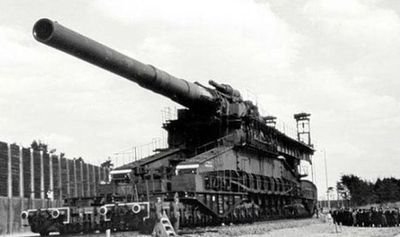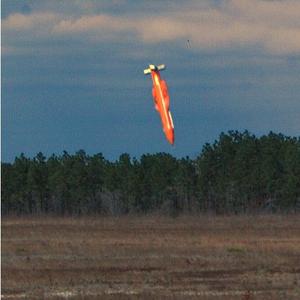The 10 Most Dangerous Weapons Ever Created

Here are ten of the most dangerous and deadly weapons that have been created by man. You won't be surprised to learn that all of these weapons are 20th century inventions, even though some of them date back thousands of years.
We'll start with three weapons that can be used by a single soldier before getting down to business.
10. RPG-7 – Rocket Propelled Grenade

With the RPG, you can fire anti-tank rockets from your shoulder! Based on Nazi Germany's Panzerfaust, it was developed into a feared anti-tank weapon. A soldier with limited training and this one weapon can destroy a multi-million dollar tank.
It was widely used against the Americans during the Vietnam War in particular, by the Viet Cong and the People's Army. When the Soviet army invaded Afghanistan, they faced the mujahideen who quickly became very adept at using RPGs against tanks and military vehicles.
RPGs remain THE threat to armored vehicles and tanks.
9. DSR-50 cal. 50 - Sniper

The DSR-50 is a sniper rifle designed to fire 50 caliber BMG bullets. It is based on the DSR-1, a specialized sniper rifle for police and other snipers. The DSR-50 has an integrated hydraulic recoil dampening system in the stock and an integrated muzzle brake that reduces perceived muzzle blast.
Designed to punch holes in (lightly) armored military vehicles, we leave it up to your imagination what happens when you shoot a person.
8. Flamethrower
What is a flamethrower? A flamethrower is classified as an incendiary device, which is specifically designed to project fire in a long, controllable stream.
Flamethrowers were first used by the ancient Greeks, as early as the 1st century AD. More recently, flamethrowers have been used throughout World War I, by the Germans, and more during World War II.
Not all flamethrowers are the same; some are designed to project a jet of fire which is caused by a flammable liquid which has been ignited. Others are designed to project a long flame of gas. Liquids are the most common type used in military flamethrowers. Commercial appliances choose to use propane and natural gases, at high pressure, because they are generally considered safer to use.
Military uses of flamethrowers are mainly focused on attacking fortifications, bunkers, etc. Civilian uses of flamethrowers tend to be more agricultural in nature; they are useful for clearing fields, for example.
Flamethrowers come in many forms; portable flamethrowers are usually two-piece devices (a backpack for fuel and a tube for exit), they can also be mounted on a vehicle for easy use.
Simple to use and maintain, you certainly don't want to be in the face of the mouth of the flamethrower spitting its flame.
7. Schwerer Gustav

Schwerer Gustav - This is the name given to a German 80cm railway gun, a huge piece of artillery designed to be fired from a railway carriage. It was developed in the late 1930s by Krupp of Essen with the aim of destroying the main forts of the French Maginot Line during a siege. At the time, these were the strongest fortifications that existed.
The "Gustav" could fire seven-ton shells at a distance of 47 kilometers. When fully assembled, the "Schwerer Gustav" weighed nearly 1,350 tons. The Germans designed this artillery piece to prepare for the Battle of France. The biggest artillery piece of WWII was not ready to fight when the battle started. But that didn't really matter as the Wehrmacht's Blitzkrieg aggression across Belgium quickly overwhelmed and isolated the static defenses of the Maginot Line, forcing them to surrender without major casualties and making the destruction of the fortifications pointless. .
The "Schwerer Gustav" was deployed later during the war in the Soviet Union. During the artillery bombardment of Sevastopol, which was part of Operation Barbarossa, among others, the big gun destroyed an ammunition warehouse buried in layers of rock under a bay.
Leningrad was the next stop for the 80cm gun and was probably intended for use in the Warsaw Uprising like other German heavy artillery weapons, but the rebellion was crushed before heavy artillery was needed . The Germans scrapped the "Schwerer Gustav" in 1945, towards the end of World War II, so that it would not be confiscated by the Soviet army.
It was the largest artillery weapon ever used in combat, the heaviest mobile artillery ever built, considering the total weight, and it fired the heaviest shells of any artillery piece.
There are only two larger caliber weapons: the British Mallet's Mortar and the American Little David mortar (both 90 cm).
6. Aircraft Carrier Nimitz

Nimitz-class aircraft carriers are the largest warships in the world. They cost around $4.5 billion each and are therefore also the most expensive. The 100,000 ton aircraft carriers can hold up to 90 aircraft and are equipped with anti-aircraft guns and missiles.
They should serve for 50 years. However, the United States is already developing its successor, which will be even bigger and is expected to cost around $12 billion.
Currently, ten Nimitz-class aircraft carriers are in service with the United States Navy. The lead ship of the class is named after the commander of the United States Pacific Fleet in World War II, Admiral Chester W. Nimitz, the last Fleet Admiral of the United States Navy.
Instead of gas turbines or diesel-electric systems that are used for the propulsion of most modern warships, aircraft carriers use two nuclear reactors that drive all four propeller shafts and can reach a maximum speed of over 30 knots. Because they use nuclear power, these massive ships can operate for over 20 years without refueling!
5. Chimera Virus
A chimeric virus is made by combining DNA from two or more other viruses.
In the 1980s, the Soviets experimented with this, taking genetic material from other viruses and injecting it into a smallpox virus, producing a chimera. This process allows the new virus to retain the virulence and appearance of smallpox under the microscope while being able to spread an entirely different infection.
This breakthrough in genetic engineering allows viral agents to evade known treatments and vaccines, making them all the more deadly.
4. The Russian thermobaric bomb

"Everything alive evaporates", is the quote from the Deputy Chief of the Russian General Staff Alexander Rukshin, when asked about their new bomb.
In 2007, the Russians successfully tested and launched their "increased power aviation thermobaric bomb", quickly dubbed the "father of all bombs" (FOAB).
The FOAB is said to be 4 times more powerful than the US military's largest non-nuclear bomb, the GBU-43/B Massive Ordnance Air Bomb, officially designated by the acronym "MOAB" and known as the "Mother of All bombs".
This makes this Russian device the most powerful non-nuclear conventional weapon in the world.
The MOAB replaces several small nuclear bombs in the Russian arsenal. It produces the equivalent of 44 tonnes of TNT while using only seven tonnes of a new high explosive.
Its blast and pressure wave have an effect similar to that of a small nuclear weapon, but on a smaller scale. The bomb explodes in mid-air, causing a supersonic shock wave and extreme temperatures.
Thermobaric weapons generate longer, more sustained shock waves with higher temperatures than conventional explosives. Because of this, they produce more damage over larger areas than conventional weapons of similar mass.
They are also unique in that they use oxygen from the atmosphere itself rather than relying on an oxidizing agent in their explosives. They produce more energy than normal and are therefore more difficult to control.
3. Intercontinental Ballistic Missile

The Intercontinental Ballistic Missile (ICBM) is a ballistic missile that is guided to the target. It can travel at least 3,400 miles and was built primarily to carry nuclear weapons.
ICBMs can be launched from aircraft, submarines, missile silos and vehicles. They became part of MAD doctrine because these weapons provided the flexibility that allowed the country to retaliate and destroy the enemy. They essentially guaranteed a second strike on the enemy.
With advances in technology, it turned out that an ICBM could be used to launch multiple nuclear warheads at once thanks to the MIRV.
2. MIRV
The MIRV, which is an Independent Multiple Target Vehicle, is a ballistic missile payload that contains multiple warheads.
Each warhead can be aimed to hit a specific target independently.
The next step was the MRV (Multiple Reentry Vehicle) missile which could carry many warheads which were all scattered but not individually targeted resulting in an explosion similar to that of a shotgun.
The MIRV fixed this issue, all warheads could now aim at different targets.
1. Tsar Bomba
All aspects of the term "weapons of mass destruction" apply to Tsar Bomba. A massive device, designed to decimate everything, that's what this bomb was. Only one was triggered, and that was enough.
The Tsar Bomba bomb remains the most powerful device ever detonated by man. To compare, the most powerful device the United States ever created was the B41. It was also the only three-stage nuclear device the United States created. The B41 had a maximum yield of 25 megatons of TNT, while the Tsar Bomba had a maximum yield of 100 megatons of TNT.
It is estimated that the mushroom cloud rose up to 40 km into the sky, which is about seven times higher than Mount Everest. At this height, the cloud has crossed the stratosphere as well as the mesosphere.
The bomb also set off a massive fireball to accompany the mushroom cloud. When triggered, the fireball nearly reached the height from which the bomb was dropped and was visible over 600 km from the site.
The bomb was basically built to flex the military strength of the Soviet Union. Because of this, the bomb was so huge that it was actually too big. What does that mean ? This means that it was impractical for wartime use. For one thing, moving the bomb was just too complicated.
She couldn't even fit on the plane that dropped her from the sky; this aircraft had to be heavily modified for the bomb. Second, the plane's crew had only a 50% chance of survival. All of this happens even after the bomb has been shrunk from its original 100 megaton size.
1 comment
Pouvez-vous me donner un ☝🏿 arme jamais construit aux mondes ?